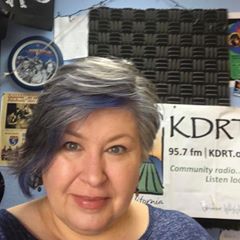
Twice weekly, on Tuesdays and Fridays, every week since March 17, Autumn Labbe-Renault, Executive Director of Davis Media Access, has gone into the KDRT studio to host her COVID-19 Community Report. She’s alone in a darkened, empty building—the center, home to both KDRT and Davis Community Television, closed to the public on March 13—and, she admits, “It weirds me out every time.” She has just wrapped Episode 19 and is booked through the end of May. “Then,” she adds, “I figure out where I go from there.”
Her program is a life-line for residents of Yolo County.
Each half-hour episode brings listeners vital information, connects people to resources and those-in-need to essential services. In these past nine weeks—while Californians have sheltered in place–, Labbe-Renault has talked with council members, congressional representatives and the Davis mayor; with public health officials and the CEO of the local hospital; with community groups offering senior services, with grab-and-go alliances offering food; with social justice activists concerned about the pandemic’s disproportionate impact on the African-American community; with teachers and school administrators; with public housing officials and legal advocates who focus on domestic violence and immigrant rights; with local business owners and non-profit administrators; with a librarian and the city’s poet laureate. Each interview leaves community members better prepared, better able to survive. And “together,” Labbe-Renault says, “all those different perspectives make up a quilt of who we are at this moment in time in the middle of this crisis.”

The Essential Service of Local Media
Beginning in early March, as the number of confirmed cases of Covid-19 began to rise in the state, patrons and volunteers at the media center struggled to take suitable precautions, stocking up on cleaning wipes and hand sanitizers, putting up signage reminding everyone to thoroughly wash their hands. But, the center was busy, full of shared equipment and high touch surfaces. It took only a week to realize it couldn’t be done. By Friday, March 13, the center closed.
“This was starting to feel like a crisis,” Labbe-Renault recalls. Another local media voice had already been silenced. Home to UC Davis, the city is, in better times, served by campus station KDVS. But that station had already gone off air. Their studio lacked automation, and campuses were closed.
“That was stunning to me,” says Labbe-Renault. “This is where local media is really important….I went to bed [questioning] how can we get information out. And I woke up in the middle of Saturday night with the idea for the radio show. By Tuesday the 17th, I was on the air with the first episode.”
A Community United and Prepared
Fueled by imminent necessity, the swiftness of the response was also the product of Labbe-Renault’s and the Davis community’s decades-long commitment to ensuring public access to local coverage by local media.
Launched in 1988 as Davis Community Television, the non-profit still maintains DCTV Public Access Channel 15. About a decade later, the organization partnered with the Davis Joint Unified School District to operate Educational Access Television Channel 17. KDRT-LP (95.7 FM), the center’s third project, went on air in 2004, becoming the first LPFM in the nation to operate within a public access television center, a center that, by 2007, in recognition of their expanded work, became Davis Media Access. The non-profit’s rationale is simple: “If we don’t do it,” says Labbe-Renault, “no one else will. That’s what it boils down to.”
Preserving Diversity and Ensuring Service for the Underserved
Davis is a medium-sized suburban city, located some 12 miles west of Sacramento in Yolo County. The county is huge and largely rural; the city opens on all sides to wide expanses of agricultural fields.
Residents of Davis do have access to Sacramento metropolitan media. But, Labbe-Renault points out, even in the best of times, Davis is only directly covered “when something’s outrageous or someone’s bleeding.”
The surrounding rural areas lack broadband penetration, lack community newspapers, lack ready information. “Here,” says Labbe-Renault, “low-power is high impact. [KDRT is] online 24/7. People listen to the live stream or catch the podcast. I knew [this program] was a good way to reach people. I was glad to be able to come up with something that makes sense, that utilized my skills.”
Executive Director of Davis Media Access since 2007 and experienced both as a newspaper journalist and in radio, when the crisis came, she had the expertise and resources to quickly launch her show.
“I think there’s a through theme there to this moment of crisis,” she continues. “Media consolidation [has] homogenized so many voices and taken away so many local news shows. Community radio is the perfect vehicle: it’s free, it’s accessible, you don’t need anything special to listen to it, you don’t have to subscribe. It’s real people in your community talking to other real people in your community about what’s important in your community.”
The Way We Live and the Work We Do
And listeners, even in, especially in, these tense times, respond. They email, leave messages on Facebook, text requests, ideas, suggestions for guests; and guests request repeat appearances. “That’s been a surprise for me,” says Labbe-Renault. “That tells me people are paying attention.”
And it is that attention, for Labbe-Renault, that stands as ultimate confirmation of what she’s always known about the impact of local media: “It’s driven home to me on a daily basis. It’s a validation. Sometimes you’re in the right work, doing the work you were intended to do. This time is carrying that out.”
COVID-19 Community Report airs on KDRT-LP (95.7 FM) twice weekly, Tuesday and Friday, at 12:00 Noon. Past programs are archived on the station’s website.
